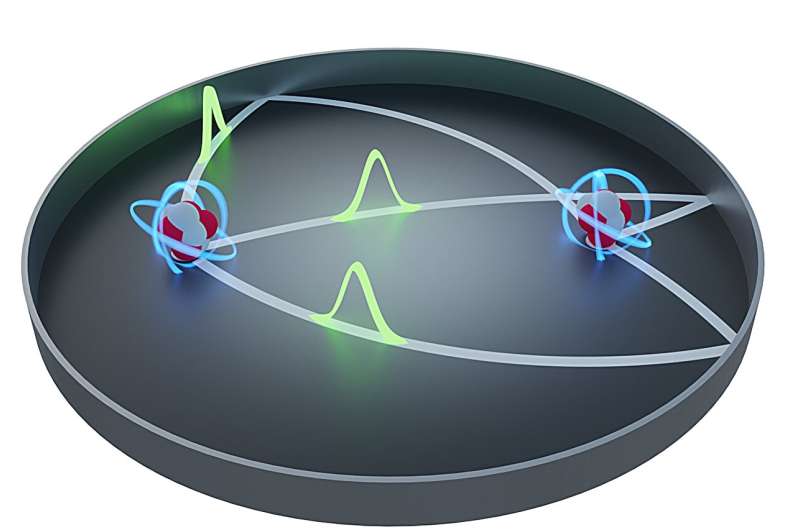Quantum Ping-Pong is come from Quantum physics which is full of surprises and paradoxes. One of them is the phenomenon of entanglement, which means that two particles can share a quantum state and influence each other, even when they are far apart. Another one is the uncertainty principle, which limits the precision with which we can measure the properties of a particle, such as its position and momentum.
But what if we could control these quantum effects and use them for our advantage? What if we could manipulate single photons, the smallest units of light, and make them interact with single atoms in a precise and predictable way? This is the goal of a new field of research called quantum optics, which aims to create novel quantum technologies based on light and matter.
In this article, we will explore one of the latest achievements in quantum optics: the creation of a “quantum ping pong” between two atoms and a single photon. We will explain how this works, why it is important, and what are the potential applications of this breakthrough.
Table of Contents
Quantum Ping-Pong: How It Works

The idea of quantum ping pong is simple: using a special lens, two atoms can be made to bounce a single photon back and forth with high precision. The lens is based on the concept of the fish-eye lens, which was developed by James Clerk Maxwell, the founder of classical electrodynamics. The lens has a spatially varying refractive index, which means that light travels faster or slower depending on where it is in the lens. This causes the light rays to bend in a curved path, instead of traveling in straight lines.
By placing two atoms at the focal points of the lens, the researchers from TU Wien in Vienna (Austria) were able to create a quantum ping pong. When one atom emits a photon, the photon travels along the curved path and reaches the edge of the lens, where it is reflected. Then, it travels along another curved path and reaches the second atom, which absorbs the photon. But the second atom does not keep the photon for long. It immediately re-emits the photon, which follows the same path back to the first atom. This process repeats itself, creating a quantum ping-pong between the two atoms and the single photon.
The researchers were able to demonstrate theoretically that this quantum ping pong is very robust and efficient. The photon is guaranteed to be reabsorbed by the second atom, regardless of the direction of emission by the first atom. The photon also does not lose any energy or information during the reflection at the edge of the lens. The quantum ping-pong can last for a long time, as long as the atoms do not decay or interact with the environment.
Quantum Ping-Pong: Why It Matters
The quantum ping pong is not just a curious phenomenon. It has important implications for the field of quantum optics and quantum technology. By controlling the interaction between two atoms and a single photon, the researchers were able to create a quantum system that can store, process, and transmit quantum information.
For example, the quantum ping-pong can be used to create a quantum memory, which can store the quantum state of a photon in the quantum state of an atom. This can be useful for quantum communication, which relies on the exchange of quantum information between distant parties. By using the quantum ping-pong, the quantum information can be preserved and protected from noise and decoherence, which are the main sources of error in quantum systems.
Another possible application of the quantum ping pong is quantum metrology, which is the science of measuring physical quantities with high precision and accuracy. By using the quantum ping-pong, the researchers were able to measure the distance between the two atoms with unprecedented precision, surpassing the classical limit imposed by the uncertainty principle. This can be useful for developing new standards of measurement and calibration, as well as for testing fundamental physics.
Conclusion
The quantum ping pong is a remarkable achievement in quantum optics, which demonstrates the power and potential of quantum technology. By using a special lens, two atoms can be made to bounce a single photon back and forth with high precision, creating a quantum system that can store, process, and transmit quantum information. This opens up new possibilities for quantum communication, quantum metrology, and quantum computation, as well as for exploring the quantum world and its mysteries.
FAQs About Quantum Ping-Pong
What is quantum ping-pong?
Quantum ping pong is a phenomenon in which two atoms can bounce a single photon back and forth with high precision, using a special lens that bends the light rays in a curved path.
How does quantum ping-pong work?
Quantum ping pong works by placing two atoms at the focal points of a fish-eye lens, which has a spatially varying refractive index. When one atom emits a photon, the photon travels along the curved path and reaches the edge of the lens, where it is reflected. Then, it travels along another curved path and reaches the second atom, which absorbs and re-emits the photon. This process repeats itself, creating a quantum ping-pong between the two atoms and the single photon.
Why is quantum ping-pong important?
Quantum ping pong is important because it can be used to create a quantum system that can store, process, and transmit quantum information. For example, quantum ping-pong can be used to create a quantum memory, which can store the quantum state of a photon in the quantum state of an atom. Quantum ping-pong can also be used to measure the distance between the two atoms with high precision, which can be useful for quantum metrology.
What are the applications of quantum ping-pong?
Quantum ping pong can enable new quantum technologies based on light and matter, such as quantum networks, quantum sensors, and quantum computation. Quantum ping-pong can also be used to explore the quantum world and its mysteries, such as entanglement, uncertainty, and interference.
Who discovered quantum ping-pong?
Quantum ping-pong was discovered theoretically by a research team from TU Wien in Vienna (Austria), led by Prof. Stefan Rotter. The team published their findings in the journal Physical Review Letters in January 2024.





